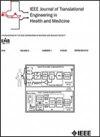Survival Prediction of Esophageal Cancer Using 3D CT Imaging: A Context-Aware Approach With Non-Local Feature Aggregation and Graph-Based Spatial Interaction
IF 4.4
3区 医学
Q2 ENGINEERING, BIOMEDICAL
IEEE Journal of Translational Engineering in Health and Medicine-Jtehm
Pub Date : 2025-04-21
DOI:10.1109/JTEHM.2025.3562724
引用次数: 0
Abstract
Accurate prediction of survival rates in esophageal cancer (EC) is crucial for guiding personalized treatment decisions. Deep learning-based survival models have gained increasing attention due to their powerful ability to capture complex embeddings in medical data. However, the primary limitation of current frameworks for predicting survival lies in their lack of attention to the contextual interactions between tumor and lymph node regions, which are vital for survival predictions. In the current study, we aimed to develop an effective EC survival risk prediction using only 3D computed tomography (CT) images.The proposed model consists of two essential components: 1) non-local feature aggregation module(NFAM) that integrates visual features from tumor and lymph nodes at both local and global scales, 2) graph-based spatial interaction module(GSIM) that explores the latent contextual interactions between tumors and lymph nodes.The experimental results demonstrate that our model achieves superior performance compared to state-of-the-art survival prediction methods, emphasizing its robust predictive capability. Moreover, we found that retaining lymph nodes with major axis使用三维CT成像预测食管癌的生存:一种具有非局部特征聚集和基于图的空间交互的上下文感知方法
准确预测食管癌(EC)的生存率对于指导个性化治疗决策至关重要。基于深度学习的生存模型因其捕获医疗数据中复杂嵌入的强大能力而受到越来越多的关注。然而,目前预测生存的框架的主要局限性在于缺乏对肿瘤和淋巴结区域之间环境相互作用的关注,而这对生存预测至关重要。在当前的研究中,我们旨在仅使用3D计算机断层扫描(CT)图像开发有效的EC生存风险预测。该模型由两个基本组件组成:1)非局部特征聚合模块(NFAM),该模块集成了肿瘤和淋巴结在局部和全局尺度上的视觉特征;2)基于图的空间交互模块(GSIM),该模块探索肿瘤和淋巴结之间潜在的上下文相互作用。实验结果表明,与现有的生存预测方法相比,我们的模型取得了更好的性能,强调了其鲁棒性。此外,我们发现保留长轴$\geq 8$ mm淋巴结的预测结果最好(c指数:0.725),为食管癌预后因素的选择提供了有价值的指导。对于仅使用3D CT图像进行EC生存预测,将淋巴结信息与肿瘤信息相结合有助于提高深度学习模型的预测性能。临床影响:美国癌症联合委员会(TNM)分类是肿瘤风险分层、预后评估和治疗决策的主要框架。然而,这种预后工具在评估食管癌患者接受多模式治疗方案的长期生存时显示出有限的预测准确性。值得注意的是,即使在相同分期参数分类的患者中,显著的结果异质性仍然存在,生存轨迹在临床匹配人群中存在显著差异。我们的模型作为TNM分期系统的补充工具。通过将患者分为不同的风险类别,该方法可以准确评估预后,并为术后辅助治疗决策(如是否进行辅助放疗或化疗)提供重要指导,从而促进个性化治疗建议。
本文章由计算机程序翻译,如有差异,请以英文原文为准。
求助全文
约1分钟内获得全文
求助全文
来源期刊

IEEE Journal of Translational Engineering in Health and Medicine-Jtehm
Engineering-Biomedical Engineering
CiteScore
7.40
自引率
2.90%
发文量
65
审稿时长
27 weeks
期刊介绍:
The IEEE Journal of Translational Engineering in Health and Medicine is an open access product that bridges the engineering and clinical worlds, focusing on detailed descriptions of advanced technical solutions to a clinical need along with clinical results and healthcare relevance. The journal provides a platform for state-of-the-art technology directions in the interdisciplinary field of biomedical engineering, embracing engineering, life sciences and medicine. A unique aspect of the journal is its ability to foster a collaboration between physicians and engineers for presenting broad and compelling real world technological and engineering solutions that can be implemented in the interest of improving quality of patient care and treatment outcomes, thereby reducing costs and improving efficiency. The journal provides an active forum for clinical research and relevant state-of the-art technology for members of all the IEEE societies that have an interest in biomedical engineering as well as reaching out directly to physicians and the medical community through the American Medical Association (AMA) and other clinical societies. The scope of the journal includes, but is not limited, to topics on: Medical devices, healthcare delivery systems, global healthcare initiatives, and ICT based services; Technological relevance to healthcare cost reduction; Technology affecting healthcare management, decision-making, and policy; Advanced technical work that is applied to solving specific clinical needs.
 求助内容:
求助内容: 应助结果提醒方式:
应助结果提醒方式:


